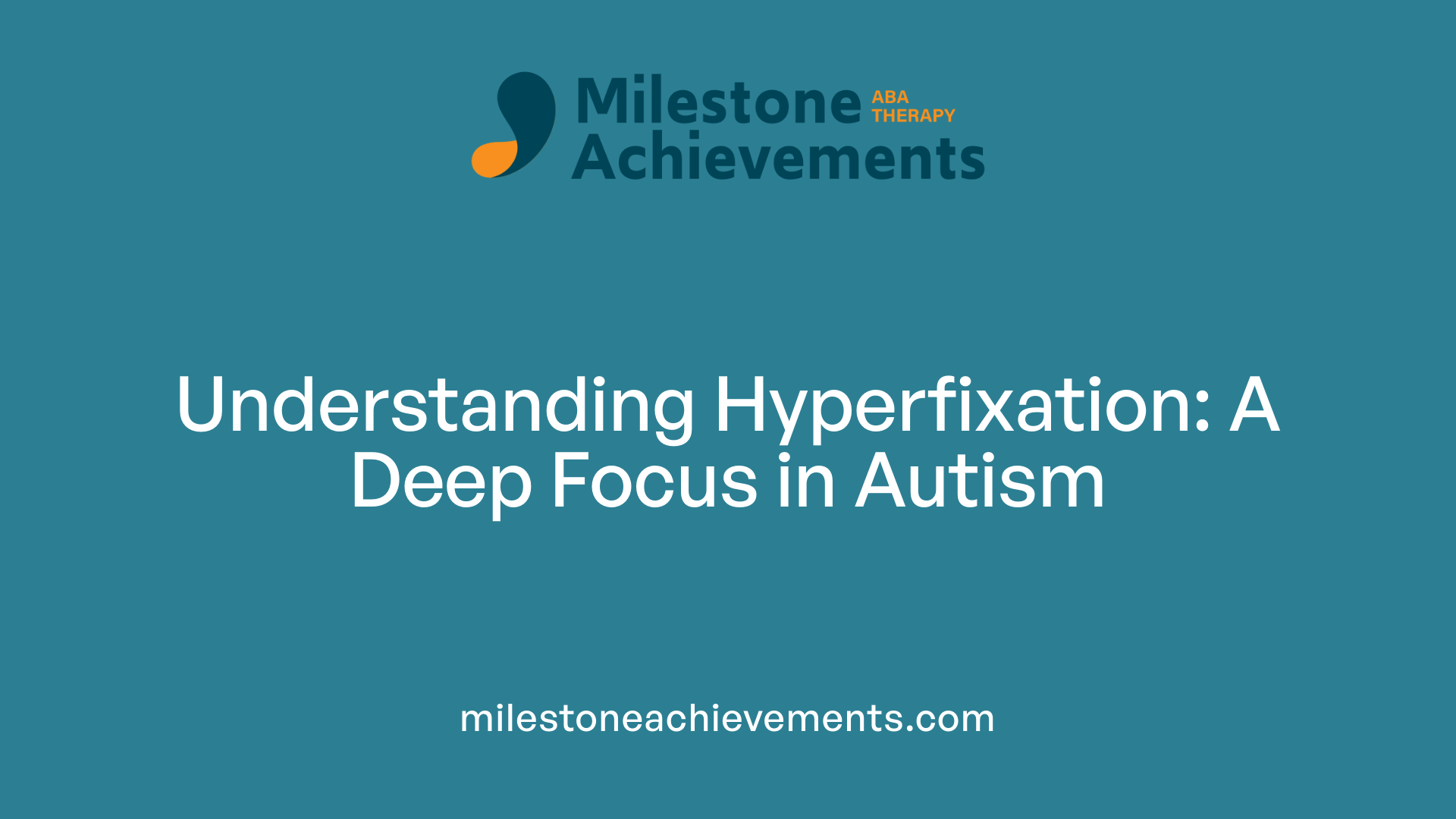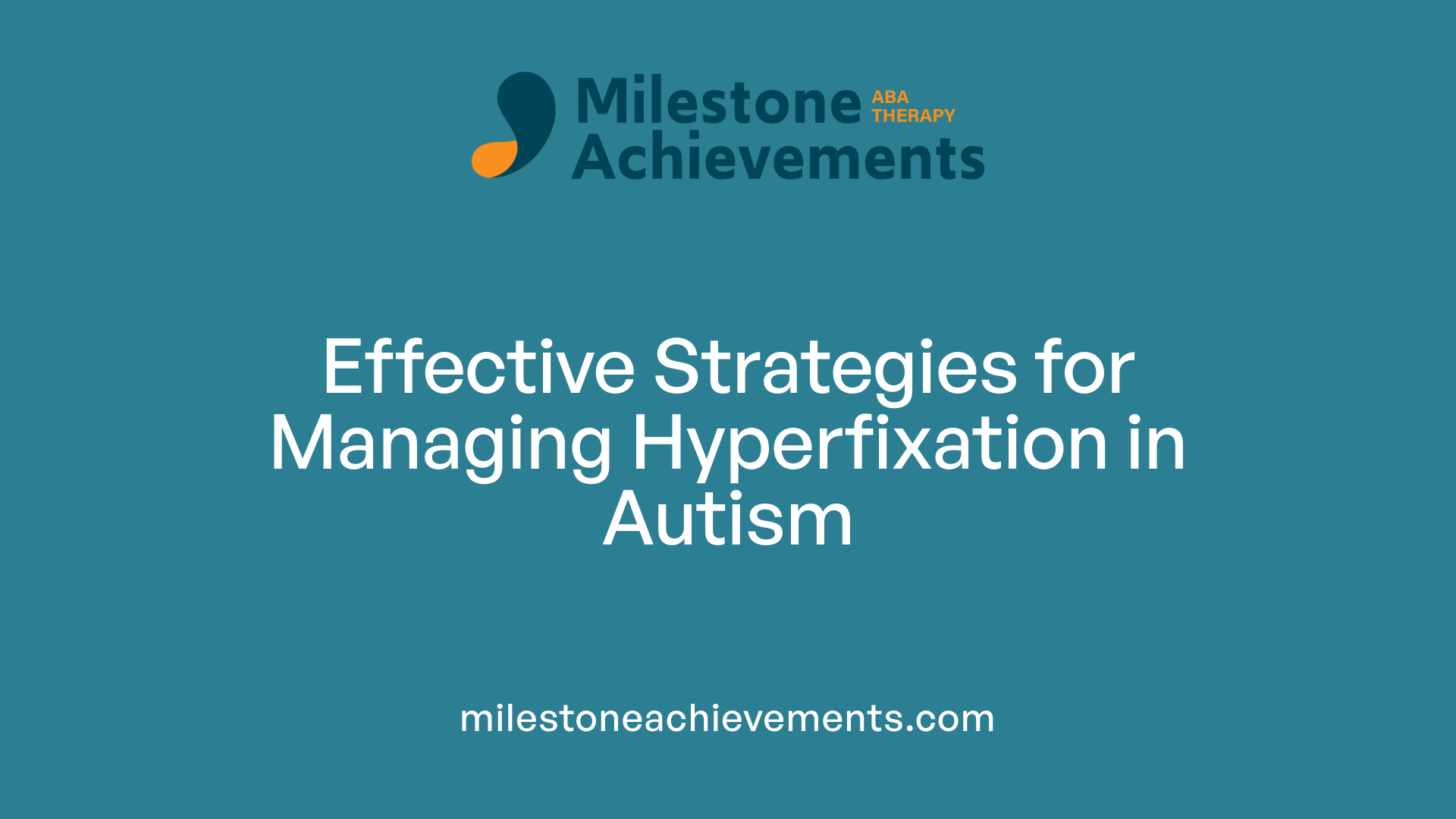
What Is a Hyperfixation Autism
Understanding the Deep Focus of Autism
Exploring the Nature and Significance of Hyperfixation
Hyperfixation is a defining feature in many individuals on the autism spectrum, characterized by a profound and sustained focus on specific interests or activities. This article unpacks what hyperfixation is, how it differs from related traits like special interests, its neurological underpinnings, manifestations, impacts, and strategies for support. Understanding hyperfixation is essential to fostering acceptance and effective assistance for autistic individuals, helping to harness its positive aspects while managing its challenges.
What Is Hyperfixation in Autism?

What is hyperfixation in autism?
Hyperfixation in autism is a state where an individual develops an extremely intense and prolonged focus on a specific interest or activity. This deep concentration often lasts for hours, days, or even months, and can be hard to break. People with autism might find themselves fully immersed in their hyperfixation, neglecting other responsibilities and daily routines.
This focus often results in extensive learning and mastery of the subject. For example, an autistic person may become an expert in topics like trains, animals, or technology, spending significant time researching, collecting related items, or engaging in related hobbies.
While hyperfixation can lead to positive outcomes like skill development, increased confidence, and creative expression, it may also pose challenges. It can interfere with social interactions or basic self-care if the focus becomes all-consuming.
In essence, hyperfixation reflects the typical autistic trait of deeply engaging with specific interests. It provides a sense of comfort, stability, and purpose, often allowing individuals to self-regulate emotional states through their intense focus.
Behavioral characteristics of hyperfixation
Individuals experiencing hyperfixation often show several distinct behaviors:
- Spending long hours engaged in their interest
- Repetitive behaviors linked to the focus
- Sharing detailed facts or knowledge about their interest
- Ignoring or neglecting personal needs or responsibilities
- Limited engagement in social activities outside their focus
- Exhibiting a strong emotional connection to their interests
Signs include losing track of time, fixation on specific objects or topics, and a tendency to talk extensively about their favorite subjects.
How does hyperfixation differ from normal focus?
While everyone can concentrate deeply on certain tasks, hyperfixation is markedly more extreme and persistent. Normal focus is usually flexible and can be redirected easily. In contrast, hyperfixation often involves an all-encompassing obsession.
It tends to be more intense, with individuals finding it difficult to shift attention away. They may engage repeatedly in the same activity, listen to the same music, or watch the same show countless times. The focus can dominate daily life, sometimes causing neglect of essential activities like eating, sleeping, or socializing.
Understanding this distinction helps caregivers and educators support individuals with autism in managing their interests while maintaining daily functioning.
Signs and Manifestations of Hyperfixation

What are common signs and manifestations of hyperfixation in autistic individuals?
Autistic individuals often display noticeable signs when they hyperfixate on a particular interest or activity. A primary indicator is an intense, unwavering focus that can dominate their attention for extended periods. They may spend hours dedicated to a single topic, such as detailed research or immersive engagement with a hobby, sometimes to the exclusion of basic needs like eating, sleeping, or self-care.
Repetitive behaviors related to their fixation are also common. These behaviors include intricate routines, ritualistic actions, or frequent usage of related media, such as watching documentaries repeatedly or playing specific games obsessively. Their conversations and thoughts often revolve solely around their interest, sharing facts or opinions extensively with others.
Hyperfixation impacts attention span, making it difficult to shift focus or respond to environmental changes. For instance, they might become unresponsive to someone calling them or ignore their surrounding environment to stay immersed in their activity.
Emotionally, hyperfixations serve important functions. They can help regulate feelings, relieve stress, and provide a sense of predictability and safety. However, this intense focus can sometimes resemble obsessive-compulsive behaviors, with compulsions rooted in the desire for comfort or control, although their underlying reasons are often specific to autism.
Overall, these signs indicate a preoccupation that is both consuming and temporary, deeply affecting daily routines and social interactions.
Neurological Foundations of Hyperfixation
What is the neurological basis of hyperfixation in autism?
Hyperfixation in autism stems from distinctive patterns of brain activity and connectivity. Research shows that individuals with autism often have atypical connections within their brains, particularly involving the association cortex which handles complex processing and integration of information.
One significant aspect is altered white matter connectivity within the same hemisphere, which can emphasize focus on specific sensations or topics. Moreover, reduced communication between the two hemispheres through the corpus callosum can contribute to a tendency for intense, localized processing.
These differences promote a neural environment where attention can become highly concentrated on particular interests, often at the expense of other stimuli or responsibilities. Interestingly, this neural setup can also be associated with preserved or even enhanced cognitive flexibility and attention to detail.
Furthermore, abnormalities in cortical inhibition and in sensory processing centers can intensify hyperfixation. These neural variations lead to a heightened state of focus, which makes shifting attention or disengaging from an interest especially challenging.
Overall, the neurobiology of hyperfixation involves a blend of overactive focus regions and subdued or altered connectivity pathways. This set-up creates a brain environment well-suited for sustained interest in specific topics or activities, characteristic of hyperfixation in autism.
Differentiating Hyperfixation From Special Interests
How does hyperfixation differ from special interests in autism?
Hyperfixation is characterized by an intense focus on a particular topic, activity, or object that tends to last for a shorter period, usually ranging from a few days up to several months. During this time, individuals may become fully absorbed, often neglecting other responsibilities, personal care, and social interactions.
In contrast, special interests are highly focused passions that develop over years, sometimes lasting a lifetime. They occupy a substantial part of a person’s free time and can expand into extensive knowledge, collection of related items, and continuous engagement. While hyperfixations are often linked to specific moments or circumstances, special interests tend to be more persistent and are a hallmark of autism spectrum disorder.
The impact on daily life and social interactions also differs. Hyperfixations may lead to neglect of responsibilities and social withdrawal when absorbed in an activity, but their transient nature means they are typically easier to shift away from after some time. Meanwhile, special interests can bolster confidence, foster social bonds if shared, and contribute positively to mental health when integrated appropriately.
Overall, the main distinction lies in duration and persistence: hyperfixations are temporary and more situational, often ending once the interest wanes, whereas special interests are enduring, long-term passions that continue influencing an individual’s lifestyle and identity.
| Aspect | Hyperfixation | Special Interests | Development Over Time |
|---|---|---|---|
| Duration | Days to months | Years or lifetime | Short-term versus long-term |
| Impact on daily life | Often disruptive, neglecting responsibilities | Can be integrated positively, support skills | Usually develop early in life, but can start later |
| Social engagement | Limited; may hinder or help social bonds | Can foster social interactions and community | Develops over years, deepens with age |
| Emotional significance | Sometimes used for regulation, escape | Personal identity, purpose | Varies; can influence self-esteem and mastery |
Supporting individuals involves understanding these differences and encouraging the positive aspects of their interests while managing any challenges. Recognizing the temporary nature of hyperfixations helps in creating effective strategies for transition and balance, whereas appreciating the long-term value of special interests can support their growth and social integration.
Supporting and Supporting Strategies for Hyperfixation Management

What strategies can support individuals with autism in managing hyperfixation?
Supporting individuals with autism who experience hyperfixation involves a combination of structured routines, practical time management tools, and therapeutic techniques.
Implementing routine structuring is fundamental. Creating daily schedules that include dedicated periods for their hyperfixation interests helps provide stability and predictability. Using visual schedules and timers sets clear boundaries, ensuring the hyperfixation does not overshadow other responsibilities.
Effective time management techniques, such as timers and alarms, help individuals regulate how long they engage with their interests. These tools promote self-awareness and encourage breaks, preventing neglect of essential activities like self-care or social interaction.
Therapeutic interventions can also be beneficial. Approaches like cognitive-behavioral therapy (CBT) help develop flexibility and manage emotional triggers associated with hyperfixation. Mindfulness and grounding exercises—such as deep breathing or body scans—enhance awareness of the present moment, aiding in shifting focus when necessary.
Building a supportive environment involves encouraging the exploration of interests alongside alternative activities. Engaging in physical activities, journaling, and trying new hobbies can diversify interests and offer healthy outlets.
A strong support network improves success. Family members, friends, or mental health specialists provide emotional guidance, help recognize early signs of hyperfixation, and assist in establishing healthy habits.
In summary, a tailored combination of routine planning, time management, therapeutic support, and emotional backing can significantly help individuals manage hyperfixation, turning it into a positive, self-enhancing experience while minimizing its challenges.
Benefits of Hyperfixation and Its Role in Emotional Well-being

How does hyperfixation benefit individuals with autism?
Hyperfixation can serve as a powerful tool for personal growth and emotional stability for autistic individuals. When someone becomes deeply engaged with a specific topic or activity, it often results in significant skill development and mastery. For instance, an autistic person might learn extensive details about a particular subject, turning into an expert or
The Importance of Respecting and Incorporating Interests in Support
 Understanding hyperfixation is essential for providing effective support and intervention for autistic individuals. These intense focus states, often seen in autism, involve full engagement with a particular interest or activity, to the point of neglecting other responsibilities. Recognizing hyperfixation allows caregivers and clinicians to turn what might seem like a distraction into a strength.
Understanding hyperfixation is essential for providing effective support and intervention for autistic individuals. These intense focus states, often seen in autism, involve full engagement with a particular interest or activity, to the point of neglecting other responsibilities. Recognizing hyperfixation allows caregivers and clinicians to turn what might seem like a distraction into a strength.
Validating interests is a vital part of building trust and motivation. When an autistic person’s hyperfixation is acknowledged, it fosters a sense of respect and helps them feel understood. This validation can encourage engagement in activities and learning, especially when interests are integrated into educational and therapeutic strategies.
Enhancing learning experiences often involves incorporating specific interests into curricula or tasks. For example, if a person hyperfixates on technology or animals, educators can develop lessons that include these themes. This approach makes learning more relevant and enjoyable, which can lead to better retention and skill development.
Building social skills is another benefit of understanding hyperfixation. Sharing and discussing interests can serve as a bridge for social interaction. When supported properly, hyperfixations can facilitate connections with others who share similar passions. This helps develop communication skills and broadens social networks.
How can understanding hyperfixation benefit support and intervention for autistic individuals?
Understanding hyperfixation enables caregivers and clinicians to identify and leverage an individual's intense interests as a strength for learning and social engagement. By tailoring interventions to align with these fixation patterns, naturalistic developmental behavioral strategies and social-communication therapies become more engaging and effective, promoting motivation and participation. Recognizing hyperfixation also aids in managing possible negatives, such as the neglect of self-care or difficulty in transitioning away from interests. This insight supports emotional regulation and overall well-being. Personalized approaches in therapies like ABA and developmental interventions help generalize skills while reducing stress for the individual and their support network.
In summary, respecting hyperfixation and using it positively can transform support strategies. It encourages not just skill acquisition but also emotional stability, social inclusion, and the fosterment of self-esteem. Emphasizing interests as a strength enhances quality of life, making support more respectful and tailored to individual needs.
Embracing Focus and Supporting Autistic Strengths
Hyperfixation is a multifaceted trait inherent to autism, embodying both remarkable potential and notable challenges. Recognizing its neurological roots, behavioral manifestations, and distinctions from related constructs like special interests fosters a comprehensive understanding. Supporting hyperfixation through structured routines, respectful acknowledgment, and strategic interventions can transform a potentially disruptive focus into a source of strength, confidence, and social connection. Embracing hyperfixation as a positive aspect of neurodiversity not only promotes inclusivity but also unlocks opportunities for personal growth, mastery, and meaningful engagement in the lives of autistic individuals. Understanding and respecting hyperfixation ultimately enhances their well-being and integration into society.
References
- Autism Hyperfixation: What You Need to Know
- Understanding and Embracing Hyperfixation in ADHD and Autism
- Autistic Hyperfixation: What Parents Need to Know - Blue ABA
- What a Hyperfixation Really Is - Time Magazine
- Special interest (autism) - Wikipedia
- Advances in Supporting Parents in Interventions for Autism ...
- Treatment and Intervention for Autism Spectrum Disorder - CDC


Partner with us on your child's journey
Milestone Achievements offers evidence-based ABA therapy to help children with autism reach their full potential. Together we’ll set meaningful goals and celebrate progress every step of the way.
Start ABA Services Today


